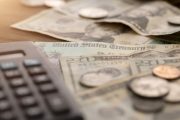
The melt-up in stock prices — increasingly being driven by the stampede of new investors operating out of fear of missing out (FOMO) — is breathtaking. The most commonly used indicator, the Standard & Poor’s 500 Index, has jumped more than 80 percent since its low last March.
Stockholdings among U.S. households have increased to 41 percent of their total financial assets in April, the highest level in history going back to 1952.
The rebound from the pandemic lows is historic: The U.S. economy is now producing at just one percent below where it was before the pandemic. This is reflected by the 6.4-percent growth rate just reported in GDP in just the first quarter of this year.
Results from U.S. companies reporting their earnings last week are an astonishing 87 percent ahead of forecasters’ expectations, above the historic average of 65 percent, and on pace for the highest level since the metric has been tracked starting in 1994.
If one looks at perhaps the best overall indicator of how well the U.S. economy is doing — Amazon — one can be persuaded that the recovery boom is likely to continue. Last Thursday, the world’s largest online retailer reported first-quarter profits of $8.1 billion, more than triple from just a year ago, before the pandemic-inspired government shutdowns were inflicted on consumers.
The retailer has now posted record profits for four quarters in a row, has attracted more than 200 million Prime loyalty customers (at about $13 a month each), and has hired more than half a million employees to keep up with the increasing demand from online shoppers.
And company officials expect that astounding growth to continue. Said Brian Olsavsky, Amazon’s soon-to-be CEO: “We expect this trend to continue as we move into the post-pandemic recovery.”
The boom on Wall Street is likely to continue as well, according to Eric Freedman, chief investment officer at U.S. Bank’s Wealth Management division: “The earnings results are really not being fully priced in [to stocks] yet.… There’s still more room [for higher stock prices].”
Jonathan Golub, chief U.S. equity strategist at Credit Suisse Securities, agrees, raising his expectations on the S&P 500 Index to $4,600 by the end of 2021. It’s currently trading at $4,200, so he’s forecasting another 10-percent rise in stocks by December.
Stock funds have attracted more than half a trillion dollars in the last five months, more money than they’ve captured in the last 12 years! More new trading accounts have been opened in history, and those new investors are not only happily chasing stocks, they’re borrowing from their brokers to do so.
But the news is not all rosy; there are some clear warning signs of another collapse. For example, total margin debt now tops $800 billion, up nearly 50 percent over a year ago. Charts tracking margin debt as a percentage of total equity holdings are now increasingly looking like they did during the last melt-up back in 2007, just before the financial crisis when stock prices collapsed.
Another warning sign is something called the “price-earnings ratio,” or PE ratio, which measures the price of stocks compared to the earnings of the companies behind those stocks. The long-term average is around 15. Today it’s 22, and climbing.
And then there’s inflation, or more accurately, price increases resulting from the previous inflation of the currency by the Federal Reserve. When the quantity of something is increased, the value of each unit falls. According to Bloomberg on Monday morning, the prices of commodities such as copper, oil, wheat, soybeans, and lumber are skyrocketing. The price increases of lumber alone have added an estimated $36,000 to the price of a new home.
But government officials are declaring that the coming wave of price increases will be “transitory.” The chair of Biden’s Council of Economic Advisors, Cecilia Rouse, said on Sunday, “These are very serious concerns … that there are going to be bumps along the way. We expect that there are going to be supply chain disruptions that will cause some transitory increases in prices.”
Yes, it’s those nasty supply-chain “disruptions” that are driving prices higher. As for increases in the general level of prices that consumers pay at the grocery and retail stores, “we do not see evidence … of runaway inflation.”
This was echoed by former Federal Reserve chair and current Treasury Secretary Janet Yellen. On Sunday, she said, “I don’t believe that inflation will be an issue. But if it becomes an issue, we have tools to address it.”
The only “tool” the Fed has, other than words, is its control of the money supply. If it dares even to suggest a reduction in the rate of growth in the money supply, or that interest rates need to rise to dampen investor and consumer enthusiasm, stocks are likely to fall, perhaps precipitously.
History, for those who have read it, teaches two things: Bubbles never last, and the day of reckoning is painful. Consider that the Roaring Twenties were driven by an “easy” Federal Reserve policy, but when the Fed started raising interest rates, stocks fell by more than 90 percent from their highs. And it took more than a decade for stocks to regain their previous levels.
If the stock market is a harbinger for the economy, investors might have another six months to enjoy the ride before the fall. That’s plenty of time for the prudent to begin taking profits.



